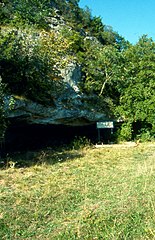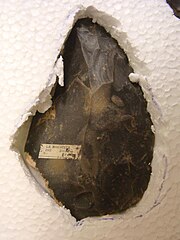
Cro-Magnon is an Aurignacian site, located in a rock shelter at Les Eyzies, a hamlet in the commune of Les Eyzies-de-Tayac-Sireuil, Dordogne, southwestern France.

Louis Lartet was a French geologist and paleontologist. He discovered the original Cro-Magnon skeletons.

Édouard Lartet was a French geologist and paleontologist, and a pioneer of Paleolithic archaeology. He is also known for coining the prehistoric taxon Amphicyon, making it one of the earliest-described fossil carnivorans in the palaeontological record.
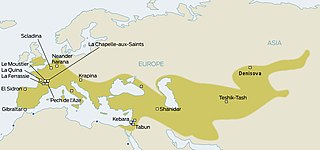
The Mousterian is an archaeological industry of stone tools, associated primarily with the Neanderthals in Europe, and to the earliest anatomically modern humans in North Africa and West Asia. The Mousterian largely defines the latter part of the Middle Paleolithic, the middle of the West Eurasian Old Stone Age. It lasted roughly from 160,000 to 40,000 BP. If its predecessor, known as Levallois or Levallois-Mousterian, is included, the range is extended to as early as c. 300,000–200,000 BP. The main following period is the Aurignacian of Homo sapiens.

Les Eyzies-de-Tayac-Sireuil is a former commune in the Dordogne department in Nouvelle-Aquitaine in southwestern France. On 1 January 2019, it was merged into the new commune Les Eyzies.

Henry Christy was an English banker and collector, who left his substantial collections to the British Museum.

The Tabun Cave is an excavated site located at Nahal Me'arot Nature Reserve, Israel and is one of the Human Evolution sites at Mount Carmel, which were proclaimed as having universal value by UNESCO in 2012.

Font-de-Gaume is a cave near Les Eyzies-de-Tayac-Sireuil in the Dordogne department of south-west France. The cave contains prehistoric polychrome cave paintings and engravings dating to the Magdalenian period. Discovered in 1901, more than 200 images have been identified in Font-de-Gaume. Along with other nearby prehistoric archeological sites, Font-de-Gaume was inscribed on the UNESCO World Heritage List in 1979 as the Prehistoric Sites and Decorated Caves of the Vézère Valley.
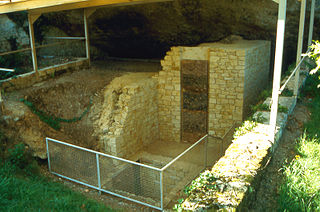
Peyzac-le-Moustier is a commune in the Dordogne department in Nouvelle-Aquitaine in southwestern France. It is known for the nearby archeological site of Le Moustier, which is a UNESCO World Heritage Site.
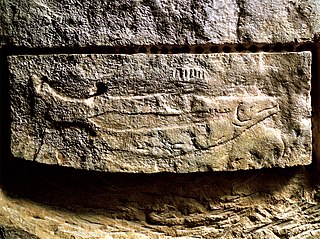
The Prehistoric Sites and Decorated Caves of the Vézère Valley is a UNESCO World Heritage Site in France since 1979. It specifically lists 15 prehistoric sites in the Vézère valley in the Dordogne department, mostly in and around Les Eyzies-de-Tayac-Sireuil, which has been called the "Capital of Prehistory". This valley is exceptionally rich in prehistoric sites, with more than 150 known sites including 25 decorated caves, and has played an essential role in the study of the Paleolithic era and its art. Three of the sites are the namesakes for prehistoric periods; the Micoquien, Mousterian, and Magdalenian. Furthermore, the Cro-Magnon rock shelter gave its name to the Cro-Magnon, the generic name for the European early modern humans. Many of the sites were discovered or first recognised as significant and scientifically explored by the archaeologists Henri Breuil and Denis Peyrony in the early twentieth century, while Lascaux, which has the most exceptional rock art of these, was discovered in 1940.
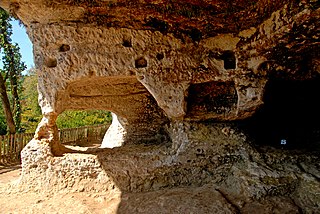
The archaeological site Abri de la Madeleine is a rock shelter under an overhanging cliff situated near Tursac, in the Dordogne département of the Aquitaine région of southwestern France. It represents the type site of the Magdalenian culture of the Upper Paleolithic. The shelter was also occupied during the Middle Ages. The medieval castle of Petit Marsac stands on the top of the cliff just above the shelter.

Raymonden is a prehistoric cave near Chancelade in the French département Dordogne. The cave was inhabited during the Upper Paleolithic and contained, besides many artefacts, a human skeleton.

The Périgord noir, also known as Sarladais, is a traditional natural region of France, which corresponds roughly to the Southeast of the current Dordogne département, now forming the eastern part of the Nouvelle-Aquitaine région. It is centered around the town of Sarlat-la-Canéda.

Laugerie-Basse is an important Upper Paleolithic archaeological site within the territory of the French commune Les Eyzies-de-Tayac-Sireuil in Dordogne. It is known for several works of art from the Magdalenian. In 1979, Laugerie-Basse, along with other nearby paleolithic sites, was inscribed on the UNESCO World Heritage List as Prehistoric Sites and Decorated Caves of the Vézère Valley.
Gibraltar 2, also known as Devil's Tower Child, represented five skull fragments of a male Neanderthal child discovered in the British Overseas Territory of Gibraltar. The discovery of the fossils at the Devil's Tower Mousterian rock shelter was made by archaeologist Dorothy Garrod in 1926. It represented the second excavation of a Neanderthal skull in Gibraltar, after Gibraltar 1, the second Neanderthal skull ever found. In the early twenty-first century, Gibraltar 2 underwent reconstruction.
Combe Grenal, also known as Combe-Grenal, is an archeological site consisting of a collapsed cave and a slope deposit near Domme, Dordogne in Dordogne, France. It dates back to c. 130,000 to 50,000 Before Present (BP).

The abri de Cap Blanc is a prehistoric limestone rock shelter with Magdalenian animal sculptures. It is in the Marquay commune on the right bank of the Beune River, a few kilometers west of Eyzies-de-Tayac, in Dordogne.

Le Regourdou is an archaeological site in the Dordogne department, France, on top of a hill just 800 m (2,600 ft) from the famous cave complex of Lascaux. At this now collapsed 35 m (115 ft) deep ancient karst cavity remarkably well preserved Neanderthal fossils were recovered, that might be skeletal remains of deliberate burials. According to the current excavation team at the site, the correct name of the location is "Regourdou". "Le Régourdou" is considered a misnomer and should be avoided.

The Cave of Aurignac is an archaeological site in the commune of Aurignac, Haute-Garonne department in southwestern France. Sediment excavation and artefact documentation since 1860 confirm the idea of the arrival and permanent presence of European early modern humans during the Upper Palaeolithic. The eponymous location represents the type site of the Aurignacian, the earliest known culture attributed to modern humans in western Eurasia. Assemblages of Aurignacian tool making tradition can be found in the cultural sediments of numerous sites from around 45,000 years BP to around 26,000 years BP. In recognition of its significance for various scientific fields and the 19th-century pioneering work of Édouard Lartet the Cave of Aurignac was officially declared a national Historic Monument of France by order of May 26, 1921.
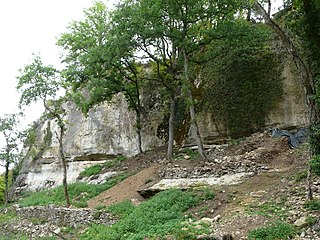
Castel Merle is a complex of 10 prehistoric rock shelters in Sergeac, in the Dordogne region of France. It is close to the Lascaux rock art caves and is situated in the region which forms the Unesco World Heritage site Prehistoric Sites and Decorated Caves of the Vézère Valley, but is not officially a part of it. The finds in the shelters date to the Mousterian and Magdalenian periods, or between 160,000 and 12,000 years ago. The most important of the 10 shelters is the Reverdit rockshelter.




